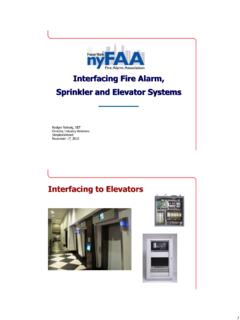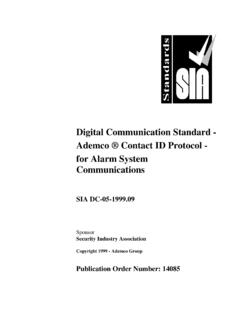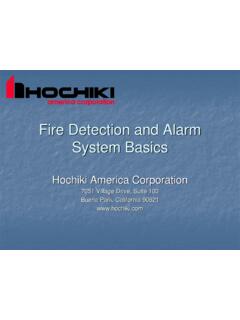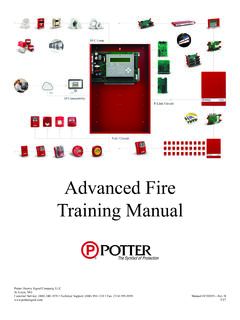Transcription of SECTION 907 FIRE ALARM AND DETECTION SYSTEMS
1 SECTION 907 fire ALARM AND DETECTION SYSTEMS General. This SECTION covers the application, installation, performance and maintenance of fire ALARM SYSTEMS and their components in new and existing buildings and structures. The requirements of SECTION are applicable to new buildings and structures. The requirements of SECTION are applicable to existing buildings and structures. Construction documents. Construction documents for fire ALARM SYSTEMS shall be of sufficient clarity to indicate the location, nature and extent of the work proposed and show in detail that it will conform to the provisions of this code, the International Building Code, and relevant laws, ordinances, rules and regulations, as determined by the fire code official. fire ALARM shop drawings. Shop drawings for fire ALARM SYSTEMS shall be submitted for review and approval prior to system installation, and shall include, but not be limited to, all of the following: 1.
2 A floor plan that indicates the use of all rooms. 2. Locations of ALARM -initiating devices . 3. Locations of ALARM notification appliances, including candela ratings for visible ALARM notification appliances. 4. Location of fire ALARM control unit, transponders and notification power supplies. 5. Annunciators. 6. Power connection. 7. Battery calculations. 8. Conductor type and sizes. 9. Voltage drop calculations. 10. Manufacturers data sheets indicating model numbers and listing information for equipment, devices and materials. 11. Details of ceiling height and construction. 12. The interface of fire safety control functions. 13. Classification of the supervising station. Equipment. SYSTEMS and components shall be listed and approved for the purpose for which they are installed. Where required new buildings and structures. An approved fire ALARM system installed in accordance with the provisions of this code and NFPA 72 shall be provided in new buildings and structures in accordance with Sections through and provide occupant notification in accordance with SECTION , unless other requirements are provided by another SECTION of this code.
3 A minimum of one manual fire ALARM box shall be provided in an approved location to initiate a fire ALARM signal for fire ALARM SYSTEMS employing automatic fire detectors or water-flow DETECTION devices . Where other sections of this code allow elimination of fire ALARM boxes due to sprinklers, a single fire ALARM box shall be installed. Exceptions: 1. The manual fire ALARM box is not required for fire ALARM SYSTEMS dedicated to elevator recall control and supervisory service. 2. The manual fire ALARM box is not required for Group R-2 occupancies unless required by the fire code official to provide a means for fire watch personnel to initiate an ALARM during a sprinkler system impairment event. Where provided, the manual fire ALARM box shall not be located in an area that is accessible to the public. Group A. A manual fire ALARM system that activates the occupant notification system in accordance with SECTION shall be installed in Group A occupancies where the occupant load due to the assembly occupancy is 300 or more.
4 Group A occupancies not separated from one another in accordance with SECTION of the International Building Code shall be considered as a single occupancy for the purposes of applying this SECTION . Portions of Group E occupancies occupied for assembly purposes shall be provided with a fire ALARM system as required for the Group E occupancy. Exception: Manual fire ALARM boxes are not required where the building is equipped throughout with an automatic sprinkler system installed in accordance with SECTION and the occupant notification appliances will activate throughout the notification zones upon sprinkler water flow. System initiation in Group A occupancies with an occupant load of 1,000 or more. Activation of the fire ALARM in Group A occupancies with an occupant load of 1,000 or more shall initiate a signal using an emergency voice/ ALARM communications system in accordance with SECTION Exception: Where approved, the prerecorded announcement is allowed to be manually deactivated for a period of time, not to exceed 3 minutes, for the sole purpose of allowing a live voice announcement from an approved, constantly attended location.
5 Emergency voice/ ALARM communication system captions. Stadiums, arenas and grandstands required to caption audible public announcements shall be in accordance with SECTION Group B. A manual fire ALARM system shall be installed in Group B occupancies where one of the following conditions exists: 1. The combined Group B occupant load of all floors is 500 or more. 2. The Group B occupant load is more than 100 persons above or below the lowest level of exit discharge. 3. The fire area contains an ambulatory care facility. Exception: Manual fire ALARM boxes are not required where the building is equipped throughout with an automatic sprinkler system installed in accordance with SECTION and the occupant notification appliances will activate throughout the notification zones upon sprinkler water flow. Ambulatory care facilities. fire areas containing ambulatory care facilities shall be provided with an electronically supervised automatic smoke DETECTION system installed within the ambulatory care facility and in public use areas outside of tenant spaces, including public corridors and elevator lobbies.
6 Exception: Buildings equipped throughout with an automatic sprinkler system in accordance with SECTION provided the occupant notification appliances will activate throughout the notification zones upon sprinkler water flow. Group E. A manual fire ALARM system that initiates the occupant notification signal utilizing an emergency voice/ ALARM communication system meeting the requirements of SECTION and installed in accordance with SECTION shall be installed in Group E occupancies. When automatic sprinkler SYSTEMS or smoke detectors are installed, such SYSTEMS or detectors shall be connected to the building fire ALARM system. Exceptions: 1. A manual fire ALARM system is not required in Group E occupancies with an occupant load of 30 or less. 2. Manual fire ALARM boxes are not required in Group E occupancies where all of the following apply: Interior corridors are protected by smoke detectors.
7 Auditoriums, cafeterias, gymnasiums and similar areas are protected by heat detectors or other approved DETECTION devices . Shops and laboratories involving dusts or vapors are protected by heat detectors or other approved DETECTION devices . 3. Manual fire ALARM boxes shall not be required in Group E occupancies where the building is equipped throughout with an approved automatic sprinkler system installed in accordance with SECTION , the emergency voice/ ALARM communication system will activate on sprinkler water flow and manual activation is provided from a normally occupied location. Group F. A manual fire ALARM system that activates the occupant notification system in accordance with SECTION shall be installed in Group F occupancies where both of the following conditions exist: 1. The Group F occupancy is two or more stories in height; and 2. The Group F occupancy has a combined occupant load of 500 or more above or below the lowest level of exit discharge.
8 Exception: Manual fire ALARM boxes are not required where the building is equipped throughout with an automatic sprinkler system installed in accordance with SECTION and the occupant notification appliances will activate throughout the notification zones upon sprinkler water flow. Group H. A manual fire ALARM system that activates the occupant notification system in accordance with SECTION shall be installed in Group H-5 occupancies and in occupancies used for the manufacture of organic coatings. An automatic smoke DETECTION system shall be installed for highly toxic gases, organic peroxides and oxidizers in accordance with Chapters 60, 62 and 63, respectively. Group I. A manual fire ALARM system that activates the occupant notification system in accordance with SECTION shall be installed in Group I occupancies. An automatic smoke DETECTION system that activates the occupant notification system in accordance with SECTION shall be provided in accordance with Sections , and Exceptions: 1.
9 Manual fire ALARM boxes in sleeping units of Group I-1 and I-2 occupancies shall not be required at exits if located at all care providers control stations or other constantly attended staff locations, provided such stations are visible and continuously accessible and that travel distances required in SECTION are not exceeded. 2. Occupant notification SYSTEMS are not required to be activated where private mode signaling installed in accordance with NFPA 72 is approved by the fire code official. Group I-1. An automatic smoke DETECTION system shall be installed in corridors, waiting areas open to corridors and habitable spaces other than sleeping units and kitchens. The system shall be activated in accordance with SECTION Exceptions: 1. Smoke DETECTION in habitable spaces is not required where the facility is equipped throughout with an automatic sprinkler system installed in accordance with SECTION 2.
10 Smoke DETECTION is not required for exterior balconies. Smoke alarms. Single- and multiple-station smoke alarms shall be installed in accordance with SECTION Group I-2. An automatic smoke DETECTION system shall be installed in corridors in nursing homes, long-term care facilities, detoxification facilities and spaces permitted to be open to the corridors by SECTION of the International Building Code. The system shall be activated in accordance with SECTION Hospitals shall be equipped with smoke DETECTION as required in SECTION 407 of the International Building Code. Exceptions: 1. Corridor smoke DETECTION is not required in smoke compartments that contain sleeping units where such units are provided with smoke detectors that comply with UL 268. Such detectors shall provide a visual display on the corridor side of each sleeping unit and shall provide an audible and visual ALARM at the care provider station attending each unit.









